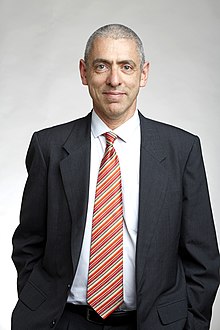Peter Dayan
Peter Dayan | |
|---|---|
 Peter Dayan at the Royal Society admissions day in London, July 2018 | |
| Born | Peter Samuel Dayan 1965 (age 53–54) |
| Alma mater | University of Cambridge (BA) University of Edinburgh (PhD) |
| Known for | Q-learning |
| Awards | Rumelhart Prize (2012) The Brain Prize (2017) |
| Scientific career | |
| Fields | Computational neuroscience |
| Institutions | Max Planck Institute for Biological Cybernetics University College London Massachusetts Institute of Technology Uber[1] University of Toronto Salk Institute |
| Thesis | Reinforcing connectionism : learning the statistical way (1991) |
| Doctoral advisor | David Willshaw |
| Influences | Geoffrey Hinton Terry Sejnowski |
| Influenced | Demis Hassabis[2][3] |
| Website | www |
Peter Samuel Dayan FRS is director at the Max Planck Institute for Biological Cybernetics in Tübingen, Germany. He is co-author of Theoretical Neuroscience, a textbook on Computational neuroscience.[4] He is known for applying Bayesian methods from machine learning and artificial intelligence to understand neural function and is particularly recognized for relating neurotransmitter levels to prediction errors and Bayesian uncertainties.[5] He co-authored an influential scientific article on Q-learning with Chris Watkins,[6][clarification needed] and provided a proof of convergence of TD(λ) for arbitrary λ.[7]
Education[edit]
Dayan studied mathematics at the University of Cambridge and then continued for a PhD in artificial intelligence at the University of Edinburgh on statistical learning [8] with David Willshaw and David Wallace, focusing on associative memory and reinforcement learning.[8]
Career and research[edit]
After his PhD, Dayan held postdoctoral research positions with Terry Sejnowski at the Salk Institute and Geoffrey Hinton at the University of Toronto. He then took up an assistant professor position at the Massachusetts Institute of Technology, and moved to the Gatsby Charitable Foundation Computational Neuroscience Unit at University College London in 1998, becoming professor and director in 2002.[9] In September 2018, the Max Planck Society announced his appointment as a director at the Max Planck Institute for Biological Cybernetics[10].
Awards and honours[edit]
Dayan was elected a Fellow of the Royal Society (FRS) in 2018.[11] He was awarded the Rumelhart Prize in 2012 and The Brain Prize in 2017.[11]
References[edit]
- ^ Ghahramani, Zoubin (2017). "Welcoming Peter Dayan to Uber AI Labs". uber.com.
- ^ Shead, Sam. "Elon Musk Signed A 350-Year-Old Book With DeepMind's Demis Hassabis". Forbes. Retrieved 9 February 2019.
- ^ Kumaran, Dharshan; Banino, Andrea; Blundell, Charles; Hassabis, Demis; Dayan, Peter (2016). "Computations Underlying Social Hierarchy Learning: Distinct Neural Mechanisms for Updating and Representing Self-Relevant Information". Neuron. 92 (5): 1135–1147. doi:10.1016/j.neuron.2016.10.052. ISSN 0896-6273. PMC 5158095. PMID 27930904.
- ^ Dayan, Peter; Abbott, Laurence (2014). Theoretical Neuroscience: Computational and Mathematical Modeling of Neural Systems. Cambridge: MIT Press. ISBN 9780262541855.
- ^ Schultz, W., Dayan, P., & Montague, P. R. (1997). A neural substrate of prediction and reward. Science, 275 (5306), 1593–1599 doi:10.1126/science.275.5306.1593

- ^ Watkins, Christopher JCH, and Peter Dayan. "Q-learning". Machine learning 8, no. 3–4 (1992): 279–292. doi:10.1007/BF00992698
- ^ Dayan, Peter. "The convergence of TD (λ) for general λ". Machine learning 8, no. 3–4 (1992): 341–362 doi:10.1023/A:1022632907294
- ^ a b Dayan, Peter Samuel (1991). Reinforcing connectionism: learning the statistical way. lib.ed.ac.uk (PhD thesis). hdl:1842/14754. EThOS uk.bl.ethos.649240.

- ^ "Peter Dayan". www.gatsby.ucl.ac.uk.
- ^ "Peter Dayan and Li Zhaoping appointed to the Max Planck Institute for Biological Cybernetics". mpg.de. Retrieved 2 October 2018.
- ^ a b "Professor Peter Dayan FRS". royalsociety.org. London: Royal Society. 2018. Retrieved 22 May 2018. One or more of the preceding sentences incorporates text from the royalsociety.org website where:
“All text published under the heading 'Biography' on Fellow profile pages is available under Creative Commons Attribution 4.0 International License.” --Royal Society Terms, conditions and policies at the Wayback Machine (archived 2016-11-11)
![]() This article incorporates text available under the CC BY 4.0 license.
This article incorporates text available under the CC BY 4.0 license.
| This biography of an academic is a stub. You can help Wikipedia by expanding it. |
| This article about a neuroscientist is a stub. You can help Wikipedia by expanding it. |